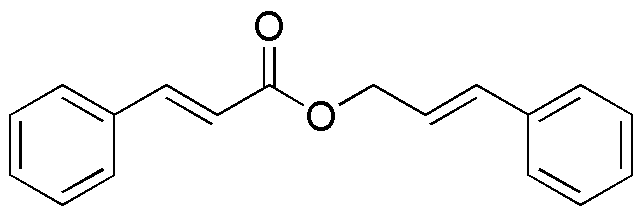Cinnamyl cinnamate is widely utilized in research focused on:
- Fragrance Industry: This compound is a key ingredient in perfumes and scented products, providing a sweet, warm, and spicy aroma that enhances the overall fragrance profile.
- Cosmetics: It is commonly used in cosmetic formulations, such as lotions and creams, due to its pleasant scent and potential skin-conditioning properties, making products more appealing to consumers.
- Food Industry: As a flavoring agent, it can be added to food products to impart a cinnamon-like flavor, which is particularly popular in baked goods and confectionery.
- Pharmaceuticals: Cinnamyl cinnamate has been studied for its potential antimicrobial and anti-inflammatory properties, making it a candidate for use in topical medications and health products.
- Research Applications: In academic and industrial research, it serves as a model compound for studying esterification reactions and the synthesis of related organic compounds, aiding in the development of new materials.
General Information
Properties
Safety and Regulations
Applications
Cinnamyl cinnamate is widely utilized in research focused on:
- Fragrance Industry: This compound is a key ingredient in perfumes and scented products, providing a sweet, warm, and spicy aroma that enhances the overall fragrance profile.
- Cosmetics: It is commonly used in cosmetic formulations, such as lotions and creams, due to its pleasant scent and potential skin-conditioning properties, making products more appealing to consumers.
- Food Industry: As a flavoring agent, it can be added to food products to impart a cinnamon-like flavor, which is particularly popular in baked goods and confectionery.
- Pharmaceuticals: Cinnamyl cinnamate has been studied for its potential antimicrobial and anti-inflammatory properties, making it a candidate for use in topical medications and health products.
- Research Applications: In academic and industrial research, it serves as a model compound for studying esterification reactions and the synthesis of related organic compounds, aiding in the development of new materials.
Documents
Safety Data Sheets (SDS)
The SDS provides comprehensive safety information on handling, storage, and disposal of the product.
Product Specification (PS)
The PS provides a comprehensive breakdown of the product’s properties, including chemical composition, physical state, purity, and storage requirements. It also details acceptable quality ranges and the product's intended applications.
Certificates of Analysis (COA)
Search for Certificates of Analysis (COA) by entering the products Lot Number. Lot and Batch Numbers can be found on a product’s label following the words ‘Lot’ or ‘Batch’.
*Catalog Number
*Lot Number
Certificates Of Origin (COO)
This COO confirms the country where the product was manufactured, and also details the materials and components used in it and whether it is derived from natural, synthetic, or other specific sources. This certificate may be required for customs, trade, and regulatory compliance.
*Catalog Number
*Lot Number
Safety Data Sheets (SDS)
The SDS provides comprehensive safety information on handling, storage, and disposal of the product.
DownloadProduct Specification (PS)
The PS provides a comprehensive breakdown of the product’s properties, including chemical composition, physical state, purity, and storage requirements. It also details acceptable quality ranges and the product's intended applications.
DownloadCertificates of Analysis (COA)
Search for Certificates of Analysis (COA) by entering the products Lot Number. Lot and Batch Numbers can be found on a product’s label following the words ‘Lot’ or ‘Batch’.
*Catalog Number
*Lot Number
Certificates Of Origin (COO)
This COO confirms the country where the product was manufactured, and also details the materials and components used in it and whether it is derived from natural, synthetic, or other specific sources. This certificate may be required for customs, trade, and regulatory compliance.

